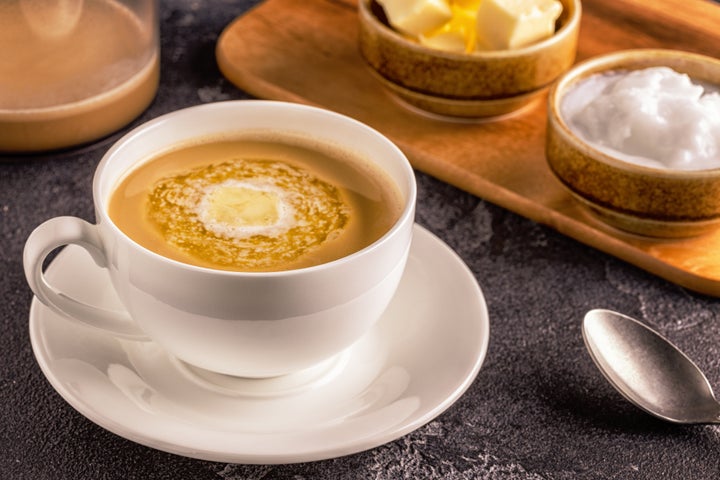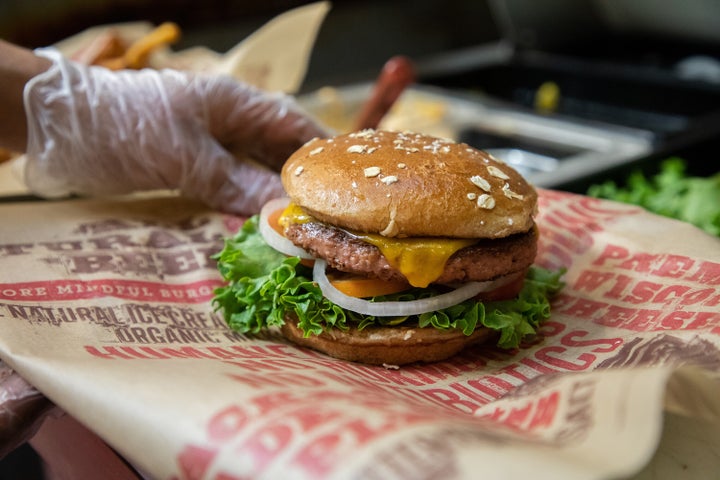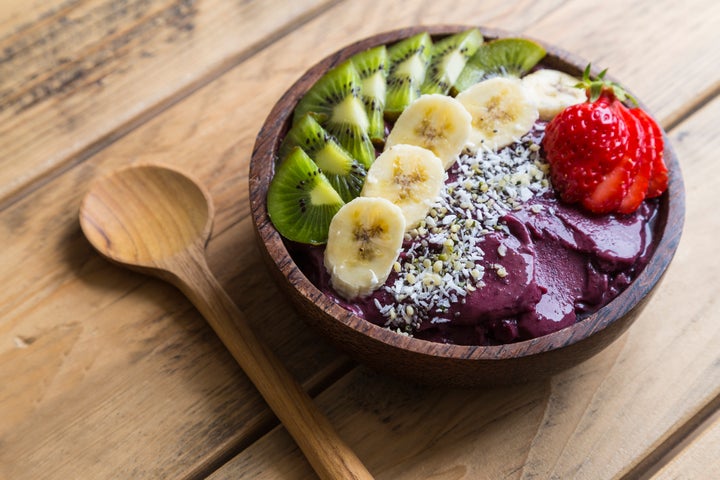On top of the classic new year’s resolution to get healthier in January, nutrition has become increasingly top-of-mind as we fight against a pandemic ― wellness could very well be our best protection. Increase your general state of health and you increase your immunity, lower your susceptibility to disease and give your body the best chance possible to fight COVID-19.
However, health halos are lurking to throw you off course.
Food marketing continues to get more buzzy and sophisticated; unfounded claims on social media go viral; and influencers earn more sway on the general populace than health professionals have. All of this makes it difficult to sort out the truth when it comes to trendy diets and claims of health benefits. We’re here to examine and shatter some of those health halos.
Juice Cleanses
At the top of the list of things that concern dietitians and nutritionists are juice cleanses, which earned a unanimous clamor of indignation from our consulted professionals.
Our bodies need macronutrients to function normally ― that means protein, complex carbs, fats and fiber. However, going on a juice cleanse deprives your body of those important fortifying elements, since your goal is to restrict all actual food and consume only juices.

“Juice cleanses ― regardless of whether they have health benefits (doubtful) ― are extremely dangerous!” registered dietitian nutritionist Casey L. McCoy of Country Doctor Community Health Centers said with an eye roll. “They typically involve restriction of most macronutrients and leaves only vitamins, mineral and sugar for quick energy that then results in a blood sugar crash since there’s no fiber. But when we restrict energy to this degree, our bodies go into energy preservation mode, prioritizing survival functions like heart pumping, breathing … but all the other functions go by the wayside. That’s why people feel so fatigued and weak when they do juice cleanses.”
“There is truly no reason to do a juice cleanse,” said Nicole Ramirez, registered dietitian and founder of Believe in Health. “There is no evidence that juicing provides any kind of detox to our bodies ― our kidneys and livers do that for us!”
All the nutritionists we spoke with said juices by themselves are not harmful when ― as all things ― they’re consumed in moderation, but cautioned strongly against replacing meals anytime, much less for days at a time, with juices.
Detox Teas
Also unpopular among the experts are detox teas, which, as McCoy put it, are “having another ‘moment’ on social media, especially among celebrity influencers.” Just as juice cleanses claim to clean out your system, so do these teas, but “the body is well equipped with organs that already work to detoxify our systems,” said nutritionist Claire Peacock, who oversees the nutrition department for MenuTrinfo in Colorado. “No drink can replace what the body naturally does.”
“The concept that you need to take certain supplements to ‘detox’ your body is a total myth,” McCoy stressed. “Rather than detoxifying your bodies, these teas include ingredients that act as laxatives and diuretics, which expel water weight and solid waste. Many experience side effects such as diarrhea and abdominal cramping.”
But the bigger risk is in dehydration and electrolyte imbalances, “which can have severe consequences for your heart,” she cautioned.
McCoy also brought up an important point of regulation ― or lack thereof. While the food we buy in stores is tightly regulated for safety by organizations like the Food and Drug Administration and U.S. Department of Agriculture, the same is not true for dietary supplements, which detox teas are classified as.
“This means anyone can sell supplements and make whatever claims they want to sell products,” she said. “That doesn’t make them true or effective, and certainly doesn’t make it safe.”
Skinny & Bulletproof Coffees
Don’t think the coffee market is safe from gimmicks. Sugary Starbucks drinks came under fire years ago when it was discovered how nutritionally void yet calorically dense they were. But now, coffee is disguising itself as a diet aid.
Ramirez called out Skinny Coffee Club as one particular culprit. The company sells coffee that’s been “reformulated to burn fat, boost antioxidants with many more benefits,” according to the brand’s website, promising noticeable weight loss within a week, higher energy and an improved complexion. However, what any coffee does is “act as an appetite suppressant and provides energy, giving the impression that you are ‘healthier,’” she said. “Once you stop these products, you’ll go back to your old habits and, thus, there is no permanent weight loss.”

Because the fact of the matter is, to lose weight, you simply need to have fewer calories coming in than you have going out. According to Ramirez, “There is no proof that Skinny Coffee Club provides weight loss results without being in a caloric deficit.”
The same goes for cult favorite Bulletproof Coffee, a favorite of keto fans that’s enhanced with grass-fed or clarified (ghee) butter and MCT (medium-chain triglyceride) oil. This intentionally high-calorie beverage is often used as a meal replacement and beloved by keto dieters and intermittent fasters (both lifestyles that have their own hosts of problems when taken too far or for too long, asserted Peacock). However, its efficacy again is in the caloric deficit it creates by taking the place of a meal. In and of itself, it’s not doing anything else to help your fitness goals. In fact, although it’s fine in moderation in conjunction with a balanced diet, Ramirez cautioned that “if you are drinking it, be aware that it is high in fat and bloodwork should be monitored accordingly.”
Alkaline Water
“A bogus waste of money!” exclaimed McCoy, and she’s quick to lay down the science.
“There is no research showing that alkaline water has any benefit over regular water,” she said. “Marketers of alkaline water claim that they help to neutralize acidity in your bloodstream to a more alkaline level,” which is a pH of 7-14 on a scale that starts at zero.
“Our bodies function optimally at a pH of 7.4, and is generally self-maintaining in this range,” McCoy continued. “Symptoms such as excessive vomiting or diarrhea or conditions like uncontrolled diabetes may result in disruptions, but since there are serious consequences to changes in our pH, our bodies are quick to detect minor changes and jump into action.”
Our body does so using two primary mechanisms, she explained: by changing our breathing rate ― making it faster to release more carbon dioxide, which is acidic when dissolved in the blood, or slower to maintain CO2 levels ― or by releasing bicarbonate from the kidneys if our pH dips or excreting it in the case of excessive alkalinity. Diets will also have no tangible impact on our pH levels for the same reasons.
You might still enjoy the crisp, sharp taste of alkaline water, but just know that its benefits end there.
‘Clean’ Wines
Drinking wine has its benefits. It’s well-documented that an occasional glass provides antioxidants, can help protect against heart disease and inflammation, may play a role in building bone density, and can positively impact your cholesterol. However, a new multilevel marketing (read: pyramid) scheme that’s generating a buzz even beyond your typical glass is “clean” wine.
Brands like Scout & Cellar are gaining momentum with alarmist marketing that makes claims that conventional “mass produced wines are scary!”— a direct quote from a recent campaign. The most egregious misrepresentation (debunked here) includes false or out-of-context statistics that say wine contains 250 additives, up to 16 grams of added sugar and an excess of sulfites. There’s also the untrue claim that “good grapes” don’t need pesticides. Rather, grapes are notoriously susceptible to mildew, rot and fungus.
Dry Farm Wines even makes the claim that its wines are “hangover-free,” which is impossible, according to the National Institute on Alcohol Abuse and Alcoholism, since alcohol is the main cause of hangovers. FitVine Wine is less dramatic about what makes it different from conventional wine, but keeps its claims vague.
Celebrities are also getting in on this industry, such as Cameron Diaz and Katherine Power with the Avaline brand. However, the one thing these wine brands have in common is a lack of opacity and a penchant for profit. “When it comes to clean wine, the only thing being cleaned is your wallet,” concluded Felicity Carter, editor-in-chief of Meininger’s Wine Business International magazine.
Essentially, “clean” or “dirty,” drink the wine you like. They’re not that different, and traditional vintners are often more transparent about their grapes, land, farming techniques and processes. Just don’t get suckered by irresponsible marketing and unsubstantiated “facts” designed to frighten consumers.
Fake Meat
Another big money-maker backed by great marketing is the fake meat industry, which is already appearing among mainstream fast food. Sure, the advantages of switching to plant-based protein are unmistakable when it comes to our planet’s wellness in terms of mitigating climate change, saving water and using less land. But for individual health? Not so much.
“Plant-based ‘meats’ often have as much saturated fat and sometimes even more sodium than a meat equivalent,” Peacock said.
Ramirez also weighed in: “While a great alternative for vegetarians and vegans, it’s not always healthier. Fake meats can often be high in sodium and also are considered a processed food.”

The level of processing is high and the list of ingredients is long. A lot of additives are required to enhance the meat-like qualities of alternatives like those made by Beyond Meat and Impossible Foods (because plants can’t naturally “bleed,” per se) and although they may not be overtly harmful, they’re not helpful to the nutritional profile, either. In fact, Beyond and Impossible burgers have comparable saturated fat levels to beef: Beyond has 6 grams, Impossible 8 grams and beef 7.6 grams. Meanwhile, studies have shown a link between eating more processed foods and a higher risk of mortality for middle-aged folks, as well as higher risks for obesity and high cholesterol.
Ultimately, as Peacock said, “they fit a need for vegetarians” and for those trying to eat more ethically, “but not necessarily for those looking to avoid meat for health-related reasons.”
Plant-Based Butters
As “plant-based” becomes an even more popular term, margarine ― or something like it, as margarine is allowed to have small amounts of dairy ― has been making a comeback. Mass-market brands like Country Crock and Land O’Lakes have joined the fray with their versions of “vegan butter” in addition to those made by burgeoning brands such as Miyoko’s and Forager Project and alternative mainstays like Earth Balance and its sister brand Smart Balance. But is it butter, when the very definition of butter means it must legally be made with a minimum of 80% milkfat, as defined by the Butter Act of 1886? The answer is a firm no on that count, making plant-based “butter” not necessarily a health halo, but a marketing lie for sure.
However it’s painted, whatever new ingredients are used to give margarine a glow-up, they’re still manufactured substitutes made from what is essentially water and one or many types of vegetable oil. At the end of the day, despite shiny stickers that may advertise lower numbers for saturated fat or cholesterol or feature added benefits that speak to today’s trends, such as cultures for tang and body, and omega-3s, they’re still 80% fat — just not milkfat.
“Just because a product is labeled ‘vegan’ doesn’t mean it’s healthy,” wrote food scientist Abbey Thiel. She called out Miyoko’s specifically for having more saturated fat than actual butter, as well as for the micronutrient deficiencies, such as vitamins A and D, that substitutes present.
“Don’t be fooled by updated commercials and fresh marketing campaigns,” she warned. “Plant butters are the same thing your mom was slathering on your toast 25 years ago.”
Açai Bowls
Açai has been touted as a superfood with miraculous health benefits, bursting onto the wellness scene like a ripe, popped berry. However, what most folks don’t know is that most açai bowls have only small amounts of this valuable fruit.
In fact, that photogenic deep purple base that you think is all superfruit is really just a puree of other fruits, thickeners and sometimes dairy alternatives for added creaminess, with just enough powdered berry or sometimes juice concentrate to give it that dramatic hue. It’s not often that it’s even frozen pure açai berry, which carries an even higher cost for an exotic fruit that already requires a lot of preparation and processing for shipment.

And all of the bells and whistles that make açai bowls so ’Grammable? The granola, peanut butter, Nutella, nuts, additional fruits, shredded coconut, honey, and a whole extra banana on top of a banana base are all sugar, fat, and other calorie bombs, making the bowls by no means a “health” or diet food.
“They are high in fiber, vitamins, and minerals,” Ramirez said, “but the large portions make them high in calories and carbohydrates and sugars in general.”
Peacock echoed that caveat. “On their own, each of the components easily fit into a well-balanced and nutrient-dense diet. However, when they all come together into a single meal, it can be a sugar overload. Looking at a couple of popular chains that sell açai bowls, they can have upward of 70 grams of sugar! With such a significant amount, it’s frustrating seeing them touted as a super healthy breakfast or snack.”
Organic And Gluten-Free Labels
Just because something is labeled “organic,” “natural” or “gluten-free” doesn’t make it the healthier choice by default. “All-natural” doesn’t legally mean anything; food manufacturers and purveyors can slap those words on anything and call it a good day in marketing. This term is not regulated by the FDA, which means there are no repercussions to calling food made with artificial ingredients, chemical sweeteners, preservatives, or anything else, “natural.”
Similar assumptions exist around organic foods. “Organic foods are sometimes deemed healthier than their conventional counterparts, but that’s not necessarily the case,” Peacock said. Just because a box of cookies is made from organic flour and sugar doesn’t make it any less a box of cookies. It could even have more calories, fat, sugar, sodium, carbs, and ingredients overall than the mass-market “regular” brands.
This halo circles around gluten-free foods, too. Many people assume they are sensitive or allergic to gluten and will thus opt for gluten-free items. However, as Ramirez said, “Gluten-free foods can be void of certain vitamins and minerals, and some gluten-free foods can have even higher sugar, fat, or sodium contents than the with-gluten items!”
“When removing gluten, you have to make up for this ingredient, which means adding things in,” she reasoned, making a gluten-free diet no “diet” at all.
Protein
Finally, another craze that’s been alarming dietitians is going heavier than needed on protein. With keto, paleo and now the carnivore diets flourishing in a world growing more distrustful of carbs, protein has been crowned the new nutritional king. However, “not all protein is created equal, which is why the FDA requires the Protein Digestibility-Corrected Amino Acid Score to be used when declaring protein claims on packaged foods,” Peacock said. “This can be an easy step for manufacturers to miss, making their claims misleading.”
What that means is that you can pore over the nutrition label and still be off in your dietary analysis.
“In addition, protein isn’t considered a nutrient of concern for most Americans,” Peacock said. For some time now, people have felt that more is more with this macronutrient, but “eating excess protein ― like any macronutrient, can lead to weight gain without any additional benefits,” she added.
So What Now?
Wellness takes work, so remain skeptical of miracles. Try not to be distracted by gimmicks and viral claims. Eat real food that hasn’t been too manufactured or processed. Stay away from trends, especially if the marketing makes you feel guilty. But above all, listen to your body and trained professionals: registered dietitians, nutritionists, medical professionals, researchers and scientists ― not the Kardashians or fitness meme creators.
This article is auto-generated by Algorithm Source: www.huffpost.com


